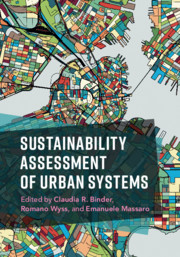Book contents
- Sustainability Assessment of Urban Systems
- Sustainability Assessment of Urban Systems
- Copyright page
- Contents
- Preface
- Acknowledgments
- Contributors
- General Introduction
- Part I Theoretical Background
- Part II Integrative Approaches for Sustainability Assessment
- Part III Perspectives on Urban Sustainability
- Part IV Focal Points of Urban Sustainability
- 15 Energy Challenges in Urban Systems
- 16 Sustainability Assessment of the Housing System: Exploring the Interplay between the Material and Social Systems
- 17 Sustainability Assessment of Urban Agriculture
- 18 Cities and Entropy: Assessing Urban Sustainability as a Problem of Coordination
- 19 Conceptualizing Urban Systems for Ecologic Sustainability Assessments: Case Study of the Stockholm Royal Seaport City District
- 20 A Study of Ride-Sharing Opportunities in the City of Santiago de Chile
- 21 Mosquito-Borne Disease and Human Mobility in Urban Environments
- Index
- References
18 - Cities and Entropy: Assessing Urban Sustainability as a Problem of Coordination
from Part IV - Focal Points of Urban Sustainability
Published online by Cambridge University Press: 27 March 2020
- Sustainability Assessment of Urban Systems
- Sustainability Assessment of Urban Systems
- Copyright page
- Contents
- Preface
- Acknowledgments
- Contributors
- General Introduction
- Part I Theoretical Background
- Part II Integrative Approaches for Sustainability Assessment
- Part III Perspectives on Urban Sustainability
- Part IV Focal Points of Urban Sustainability
- 15 Energy Challenges in Urban Systems
- 16 Sustainability Assessment of the Housing System: Exploring the Interplay between the Material and Social Systems
- 17 Sustainability Assessment of Urban Agriculture
- 18 Cities and Entropy: Assessing Urban Sustainability as a Problem of Coordination
- 19 Conceptualizing Urban Systems for Ecologic Sustainability Assessments: Case Study of the Stockholm Royal Seaport City District
- 20 A Study of Ride-Sharing Opportunities in the City of Santiago de Chile
- 21 Mosquito-Borne Disease and Human Mobility in Urban Environments
- Index
- References
Summary
Assessing urban sustainability is a crucial step towards solving the challenges we face today. Solutions to these challenges are likely to demand new and impressive levels of coordination: people will need to change their habits and learn to focus their actions in specific sustainable directions. The deeper nature of such challenges may be clarified through a classic concept from information theory and thermodynamics: entropy, both a measure of probability in the face of uncertainty and a measure of disorder. Arguing that the problem of entropy may throw light on issues of sustainability in social and urban systems, we propose in this chapter that sustainability can be stimulated by cities that enable us to coordinate better, reducing the entropy triggered by uncertainties and the unintended consequences of our actions. Investigating the role of cities in social entropy through a new agent-based model (ABM), we show that cities may play a crucial role in our conscious and unconscious efforts to cooperate.
- Type
- Chapter
- Information
- Sustainability Assessment of Urban Systems , pp. 438 - 459Publisher: Cambridge University PressPrint publication year: 2020



